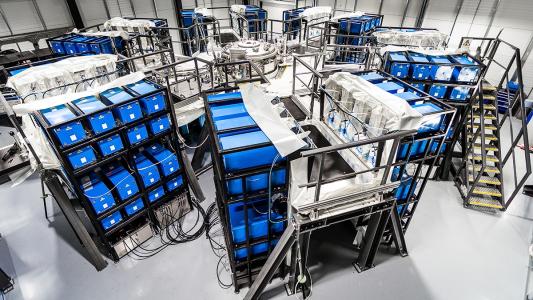Oxfordshire's First Light Fusion, the world’s leading inertial fusion company, has successfully increased the ‘standoff’ distance – the distance travelled by the projectile to the fusion target – by more than 10 times.
The major milestone will help solve one of the key engineering challenges in designing a projectile fusion power plant. It forms part of the Oxford-based firm’s ongoing work to design a pilot power plant capable of producing commercial energy from fusion.
First Light is pursuing a new form of inertial confinement fusion using its unique amplifier designs. The amplifier approach changes the 'driver' requirements, unlocking new approaches including a high velocity projectile. This creates the extreme temperatures and pressures required to achieve fusion by compressing a target containing fusion fuel using a projectile travelling at a tremendous speed. ‘Standoff’ distance is the distance between where the ‘projectile’ is launched and the ‘target’ – where the fusion implosion happens.
The challenge is to be able to launch a projectile accurately, at velocities of several kilometres per second while keeping it in a solid state when it hits the fusion fuel. This is a major challenge in First Light’s approach with its pilot power plant design requiring the projectile to be fired at very high speeds and accuracy.
First Light’s Machine 3 – a pulsed power machine that launches projectiles electromagnetically – has been used for this research for several years, with the highest standoff distance previously achieved being 10mm. This is sufficient for testing the design of its amplifier technology. In a power plant, the standoff distance required is required several metres.
As part of its experimental programme, this month First Light successfully increased the standoff distance from 10mm to 10cm – an increase of 10 times. The experiment used a design called the “electric gun”. The aim was to explore if an electric gun design could be launched to high velocity on a high energy pulsed power machine without melting, a key requirement for achieving standoff.
The projectile was maintained in a solid state over 10 cm through careful tailoring of the electric gun foil and projectile thicknesses to the M3 current pulse. The desired thicknesses were determined using simulations of the material strength, which allowed for the projectile design to maintain its strength over a flight distance of 10cm.
As well as meeting the main objective, the shot was also the highest energy electric gun ever tested.
In December 2022, the significant demonstration of Ignition was achieved by the National Ignition Facility in the US. As a result, more inertial fusion companies, including First Light, are now investing greater resource on solving the key engineering hurdles that need to be overcome to realise commercial fusion energy.
An inertial fusion power plant operates a continual pulsed process. With First Light’s amplifier approach, its power plant will work like an internal combustion engine whereby the amplifier target contains the fuel, and its fusion driver – a projectile fired at speed – is the spark plug. The target will be dropped into the reaction chamber, and then the projectile will be fired at the target to create fusion.
First Light’s aim is to design the lowest risk and simplest, most scalable plant design possible. By increasing the energy per shot, and reducing the frequency, First Light aims to achieve a smaller overall plant size with a much lower risk.
There is a large amount of existing engineering that can be used to realise this plant design. First Light is working to tackle the remaining engineering challenges in designing a power plant, one of which is the standoff distance. The company’s advanced simulation capability allows it to trial thousands of options for this at pace.
First Light now has a team of five scientists and engineers working full time on the design and development of a pilot power plant, headed up by Jorge Fradera. This month’s successful attempt to increase the stand-off distance was led by Mila Fitzgerald, a PhD student at the University of Oxford who has worked at First Light for over three years.
Mila Fitzgerald, a Scientist at First Light Fusion, said: “This is a milestone moment for First Light and the result of a huge amount of effort, time, and perseverance from the whole team.
“As we scale up our approach and look to design a pilot power plant based on First Light’s projectile approach – one of the key challenges is being able to fire a projectile at high speeds and from a further distance. That is the basis of our current pilot plant design.
“This experiment demonstrates a way for us to do that and is an exciting step in the right direction.”
Dr Nick Hawker, Founder & CEO of First Light Fusion, commented: “As we move into the era of commercialisation of fusion energy, solving the key engineering challenges in a power plant is a core focus for the First Light team.
“We know the physics of inertial fusion works. Our recent success at Sandia shows that our amplifiers work. To reach commercial, cost-effective, and scalable fusion energy as part of our future energy mix, we need to solve the power plant fundamentals, and in a way that works with the physics.
“With our unique approach, a first-of-its-kind fusion power plant is designed to be as simple and low risk as possible, simplifying the pathway to commercial fusion energy. We have taken on the standoff challenge because it unlocks huge benefits elsewhere. This is a very significant derisking moment. There is further work to do. Now we have a solid projectile, we move on to studying and controlling the accuracy of launch.”
